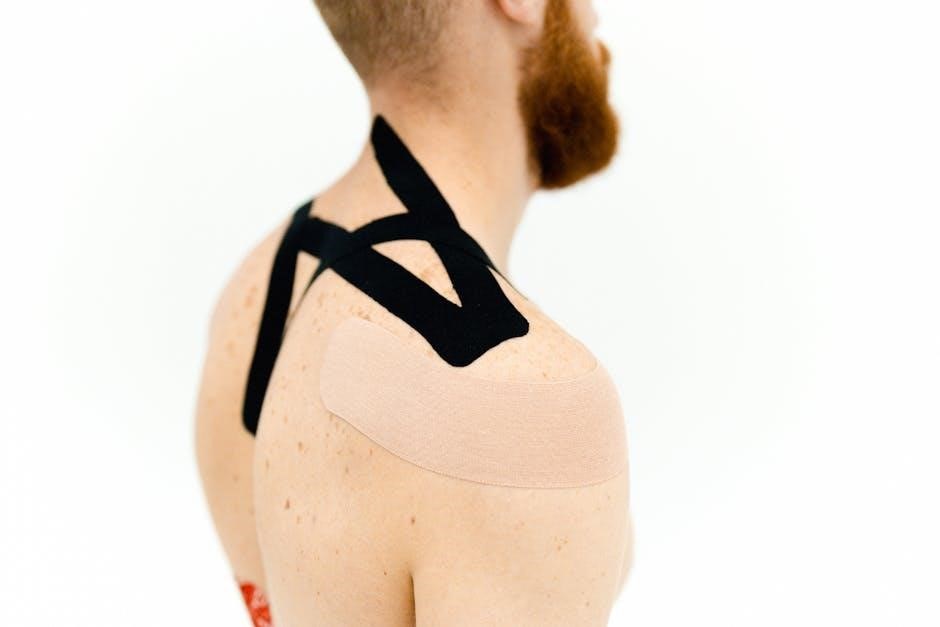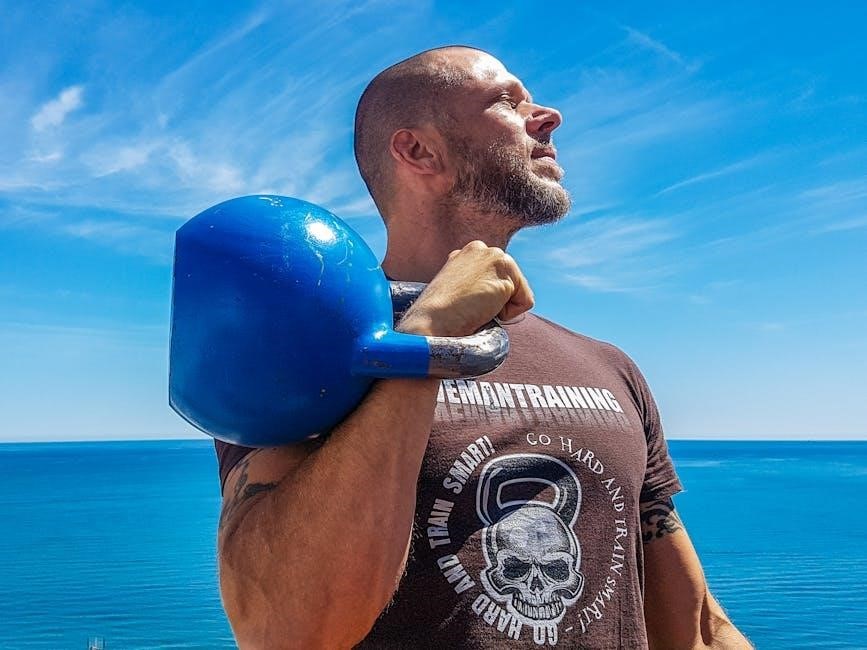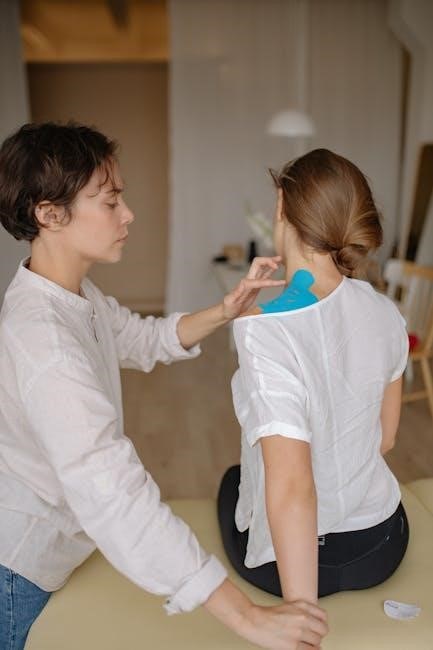
Dislocated shoulder exercises are crucial for restoring mobility, strength, and stability. Consistent practice, as guided by healthcare providers, ensures safe and effective recovery from shoulder dislocations.
1.1 Understanding the Importance of Rehabilitation
Rehabilitation after a dislocated shoulder is essential to restore joint stability, strength, and range of motion. Without proper rehab, the shoulder may remain unstable, leading to recurring dislocations or chronic pain. A structured program helps prevent complications like frozen shoulder or chronic instability. Early mobilization and strengthening exercises are critical to avoid prolonged stiffness and weakness. Rehabilitation also addresses muscle imbalances and improves proprioception, ensuring better joint function. Consistent adherence to rehab protocols minimizes recovery time and reduces the risk of future injuries. It’s a gradual process that transitions from immobilization to active movements, ensuring a safe return to daily activities or sports. Proper rehabilitation lays the foundation for long-term shoulder health and functionality.
1.2 Overview of Shoulder Anatomy and Function
The shoulder is a complex ball-and-socket joint consisting of the humerus, scapula, and clavicle. It is stabilized by ligaments, tendons, and muscles, including the rotator cuff, which plays a crucial role in maintaining joint stability. The shoulder’s unique anatomy allows for a wide range of motion, making it one of the most mobile joints in the body. However, this mobility also makes it prone to dislocations. Understanding the shoulder’s structure helps in appreciating how injuries, such as dislocations, impact its function. The deltoid muscle and rotator cuff work together to enable movements like flexion, abduction, and rotation. Proper functioning of these components is essential for preventing recurrence of dislocations and ensuring full recovery.
Immediate Post-Injury Phase (0-2 Weeks)
The immediate post-injury phase focuses on immobilization, pain management, and initial isometric exercises to promote healing and stability without overstraining the shoulder joint.
2.1 Immobilization and Pain Management
Immobilization is critical immediately after a shoulder dislocation to prevent further injury; A sling is typically used to keep the arm stable and comfortable. Pain management often involves ice packs and prescribed medications to reduce swelling and discomfort. Patients are advised to avoid driving, sports, or manual labor until cleared by a clinician. Early immobilization helps the shoulder joint heal properly, minimizing the risk of recurrent dislocations. It’s essential to follow the healthcare provider’s guidelines to ensure optimal recovery during this phase.
2.2 Initial Isometric Exercises
Initial isometric exercises are essential during the first few weeks post-injury to maintain shoulder strength without risking further dislocation. These exercises involve contracting the shoulder muscles without moving the joint. Examples include shoulder adduction, flexion, and external rotation, often performed with a pillow or against gentle resistance. Patients are typically advised to perform 10 repetitions of each exercise, 3-4 times daily. These exercises help stabilize the shoulder joint, reduce muscle atrophy, and prepare the shoulder for more active movements in later phases. Consistency is key to building a strong foundation for recovery and preventing future instability.

Early Rehabilitation Phase (2-4 Weeks Post-Injury)
3.1 Passive and Active-Assisted Range of Motion Exercises
These exercises, starting 3 weeks post-injury, improve shoulder mobility by gently moving the joint with assistance, reducing stiffness and promoting recovery without overexertion.
Passive and active-assisted range of motion exercises are essential during the early rehabilitation phase. These exercises, typically starting 3 weeks post-injury, aim to restore shoulder mobility without putting excessive strain on the joint. Passive exercises involve a therapist or helper moving the shoulder through gentle motions, such as abduction, flexion, and external rotation, while the patient remains relaxed. Active-assisted exercises allow the patient to participate by using their other arm or a device, like a wand, to guide the movements. These exercises help reduce stiffness, improve joint alignment, and prepare the shoulder for more dynamic movements. Consistency and adherence to prescribed routines are crucial for optimal recovery and minimizing the risk of further injury.
3.2 Shoulder Pendulum and Wall Slide Exercises
Shoulder pendulum and wall slide exercises are gentle, non-weight-bearing movements designed to enhance shoulder mobility and reduce stiffness. The pendulum exercise involves leaning forward slightly, letting the affected arm hang freely, and gently swinging it in small circles or side-to-side motions. Wall slides require standing with the affected arm against a wall and sliding it upward, using the wall for support. These exercises promote controlled movement, improve joint alignment, and strengthen the shoulder without putting excessive strain. They are typically performed 4-5 times daily, with 10 repetitions per session, and are particularly effective during the early rehabilitation phase to gradually restore range of motion and prepare for more advanced exercises.

Strengthening Phase (4-8 Weeks Post-Injury)
This phase focuses on rebuilding shoulder strength, emphasizing rotator cuff and scapular stabilization exercises to restore function and prevent future dislocations, gradually increasing resistance and intensity.
4.1 Rotator Cuff Strengthening Exercises
Rotator cuff exercises are essential for rebuilding strength and stability after a shoulder dislocation. These exercises target the four muscles of the rotator cuff, which are crucial for shoulder function. Common exercises include external rotations, internal rotations, and shoulder abductions. Resistance bands or light weights can be used to gradually increase intensity. It is important to perform these exercises with proper form to avoid further injury. Consistency is key, as strengthening the rotator cuff helps prevent future dislocations and restores normal shoulder movement; These exercises should be done 2-3 sets of 10-15 repetitions, 3-4 times a week, as part of a comprehensive rehabilitation program.
4.2 Scapular Stabilization Exercises
Scapular stabilization exercises focus on strengthening the muscles around the shoulder blade, improving posture and reducing the risk of future dislocations. These exercises include shoulder blade squeezes, push-ups, and rows. Proper form and controlled movements are essential to target the correct muscles without straining the shoulder. Performing these exercises regularly helps restore balance and stability to the shoulder joint, promoting long-term recovery. They should be incorporated into the strengthening phase of rehabilitation, typically 4-8 weeks post-injury, and continued as part of a maintenance routine to ensure optimal shoulder health and functionality.

Advanced Rehabilitation Phase (8-12 Weeks Post-Injury)
This phase focuses on progressive resistance and functional training to restore normal shoulder function and prepare for return to activity, ensuring long-term stability and strength.
5.1 Progressive Resistance Exercises
Progressive resistance exercises are essential in the advanced phase, focusing on strengthening the shoulder muscles gradually. These exercises include resisted shoulder external rotation, internal rotation, and abduction. Resistance can be applied using light weights, resistance bands, or isokinetic devices. The goal is to improve muscle endurance and power, preparing the shoulder for more dynamic movements. Exercises like shoulder external rotation at 90 degrees and resisted shoulder extension are commonly recommended. It’s important to perform these exercises with proper form to avoid re-injury. Supervision by a physical therapist is often advised to ensure safety and effectiveness. These exercises help restore functional strength, enabling a return to daily activities or sports. Consistency and gradual progression are key to achieving optimal results.
5.2 Functional and Sport-Specific Training
Functional and sport-specific training is the final phase, aiming to restore the shoulder’s ability to perform daily and athletic tasks. Exercises mimic real-life movements, such as overhead reaching or throwing, tailored to the individual’s activities. For athletes, drills like modified throwing or catching are introduced, progressing to full intensity. Balance and coordination exercises, like single-arm stability tasks, enhance proprioception. The focus is on integrating strength with agility, ensuring the shoulder can handle dynamic stresses. A gradual return to sport is emphasized, with careful monitoring to prevent overexertion. This phase ensures a smooth transition back to normal function, reducing the risk of future dislocations and optimizing performance. Customized plans are often necessary to address specific sport requirements, ensuring comprehensive recovery.

Preventing Future Dislocations
Preventing future dislocations involves maintaining shoulder strength, flexibility, and proper warm-up techniques. Consistent exercise routines and avoiding risky movements are key to long-term stability and injury prevention.
6.1 Maintaining Shoulder Strength and Flexibility
Maintaining shoulder strength and flexibility is essential for preventing future dislocations. Regular exercises targeting the rotator cuff, deltoid, and scapular muscles help stabilize the joint. Isometric exercises, such as shoulder external rotation and internal rotation, improve muscle endurance without putting excessive strain on the shoulder. Incorporating flexibility exercises, like shoulder flexion and cross-body stretches, enhances range of motion and reduces stiffness. Consistency is key; performing these exercises 3-4 times weekly ensures long-term joint stability. Gradually increasing resistance or difficulty as strength improves further reinforces the shoulder’s resilience. Proper form and technique are crucial to avoid re-injury, making guided routines or professional oversight highly recommended.
6.2 Proper Warm-Up and Cool-Down Techniques
Proper warm-up and cool-down techniques are vital for maintaining shoulder health and preventing dislocations. Begin with gentle exercises like shoulder circles, neck stretches, and arm swings to increase blood flow and flexibility. Dynamic stretching, such as arm circles and cross-body stretches, prepares the muscles for activity. After exercise, incorporate static stretches to improve range of motion and reduce muscle tension. Techniques like scapular squeezes and side stretches can enhance joint stability. Allocate 10-15 minutes for these routines, ensuring smooth transitions between rest and activity. Regular practice improves flexibility, reduces stiffness, and strengthens the shoulder muscles, minimizing the risk of future dislocations.